891 Search Results for core vocabulary
July 30, 2017
by Carole Zangari -
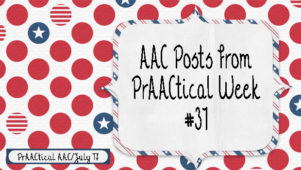
Therapy sessions, interviews, classes, make-and-take, hands-on strategy practice, report-writing….It’s been an action-packed week around here, full of AAC and literacy learning. If you also had a busy week, you probably missed a few of these posts. Monday: PrAACtically August – AAC Resources for A Year of Core Vocabulary Words Wednesday: When Helping Isn’t Helping-Prompt Awareness in AAC Instruction Thursday: Throwback Thursday – Support for Beginning AAC Communicators :::::::::::::::::::::::::::::::::::::::::::::::::::::::::::::::::::::::::: Looking for a few other posts to browse through? Here are some on AAC assessment that might be of interest. AAC Skills Assessment for Direct Selectors Observational Assessment of Beginning Communicators AAC Assessment for Children Who Speak AAC assessment modules AAC Assessment Forms See you next time!
July 16, 2017
by Carole Zangari -

Hope your weekend is going well. Here are some posts from our prAACtical week. Monday: 3 Presentation Handouts on Core Vocabulary Implementation Wednesday: Video of the Week: Parent Collaboration in AAC Therapies Thursday: Core Vocabulary, AAC Resources and Beyond Looking for activities for adolescents, teens, and adults? The AT Team at ChoR has some great ideas for us! Scrapbooking and computer Nailpolish and magazines Cooking (with picture recipes) You can see all their AT Recipes for Success here. Have a great week!
July 9, 2017
by Carole Zangari -
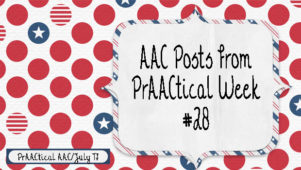
Summer is in full swing here and it is too hot to do much of anything strenuous. If you’re in the mood to peruse some AAC-related posts, we have a few suggestions. Monday: Site of the Month: UDL Technology Tuesday: Happy Independence Day! Wednesday: Video of the Week: Beyond the Basics – Core Considerations in AAC Intervention Thursday: PrAACtical Questions with Vicki Clarke: What’s the Role of Core Vocabulary? Looking for things to do this week? Here are some posts with suggestions for core word activities that incorporate language learning with motor activities and sensory play and printable handouts for parents and others. AT Recipes for Success with Young AAC Learners Bubbles and Cars Ball Play and Dolls Paint Dotters and Crayons Potato Head and Animal Puzzles
July 2, 2017
by Carole Zangari -
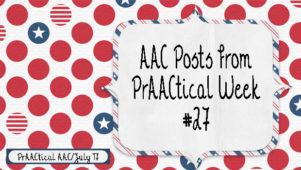
Happy July, AAC friends! Monday: PrAACtically July: AAC Resources for A Year of Core Vocabulary Tuesday: PrAACtical Learning with AAC in the Cloud Wednesday: Video of the Week: Supporting AAC Learners in Working with Words Thursday: AACtual Therapy-AAC Intervention for Beginning Communicators: Presume Competence and Be the Fun No matter where you live, AAC is something to celebrate!
June 25, 2017
by Carole Zangari -
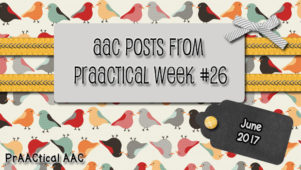
Busy week? Here are a couple of posts that you might have missed. Monday: Administratively Speaking: 5 Considerations for Recruiting and Retaining AAC SLPs (Part 2) Wednesday: Video of the Week: Object Symbols and Core Vocabulary And while we’re at it, here are a few throwbacks on topics of prAACtical interest. AAC and Emergent Literacy SMORRES From Solitary Play to Interaction: 5 Things to Try with Kids Who Love Their iPad Games Have a great week!
June 18, 2017
by Carole Zangari -
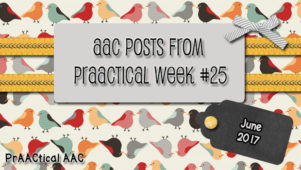
My week was jam-packed with AAC and literacy. If your week was just as busy, you might have missed a post or two. Monday: AAC In the Classroom: Considerations for Modeling Core Vocabulary Wednesday: Video of the Week: Breaking Down Barriers to Inclusive Education for AAC Learners Thursday: How I Do It: A Year of Core Words in Action
June 4, 2017
by Carole Zangari -
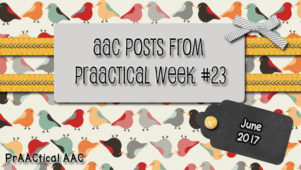
Here are some AAC posts that you may have missed in your busy week. Monday: A Thought on Memorial Day Wednesday: Video of the Week: Aided Language Input During Play Thursday: AAC in the High School Classroom: Where Core Vocabulary Meets Life Skills
May 11, 2017
by Carole Zangari -
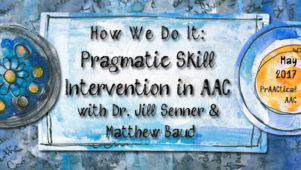
Better Hearing and Speech Month is in full swing and we are excited to see SLPs talking about tools and strategies for supporting people with AAC needs. Many individuals with AAC needs have difficulty using language in expected ways, particularly in social interactions. In this post, we welcome back guest authors Jill Senner and Matthew Baud to discuss ways in which they target pragmatic language in their clinical work. They have a prAACtical approach to this subject and are generous in sharing AAC resources, including vocabulary/pagesets for some popular AAC apps/SGDs. Enjoy! ::::::::::::::::::::::::::::::::::::::::::::::::::::::::::::::::::::: Chat with Me: Pragmatic Skill Intervention in AAC with Jill E Senner, PhD, CCC-SLP & Matthew R. Baud, MS, CCC-SLP Pragmatic skills, commonly referred to as social skills, play an important role in the successful integration of individuals with disabilities. People with disabilities need adequate social skills to live and be educated in the least restrictive environment, to be... [Read More...]
May 8, 2017
by Carole Zangari -
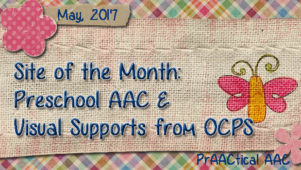
Where can I go to get AAC-friendly resources for preschool children? Join us as we explore the Wiki sharing space by the Exceptional Student Education Program of Orange County Public Schools in the Orlando, Florida area. Over the years, their AT team and others have compiled an impressive group of materials that can be used by teachers, therapists, and parents. You can see guest posts on Essential Tricks for Supporting AAC in Schools by some of the team here and here. In this post, we feature one of their webpages that is used for resource sharing. Many of the files are in Boardmaker format, but there are also some in Word and PDF document formats. Most of the resources are available from the menu on main page (click here). Highlights from this site include: Unit-based Resources (including classroom and therapy materials, parent letter, & more) are accessible from the main page Me &... [Read More...]
April 30, 2017
by Carole Zangari -
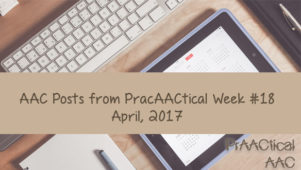
Just when it is time to say goodbye to April and wrap up Autism Awareness and Acceptance Month, we have another reason to celebrate. May is Better Hearing and Speech Month (BHSM), and that gives us a powerful opportunity to spread the word about supporting people who use AAC. Stay tuned for BHSM ideas and resources. In the meantime, though, why not catch up on some of last week’s posts? Monday: Using Adapted Books with AAC Learners: 3 Important Questions to Ask Wednesday: Video of the Week: AACtually Communicating Thursday: PrAACtically May: AAC Resources for A Year of Core Vocabulary Words









